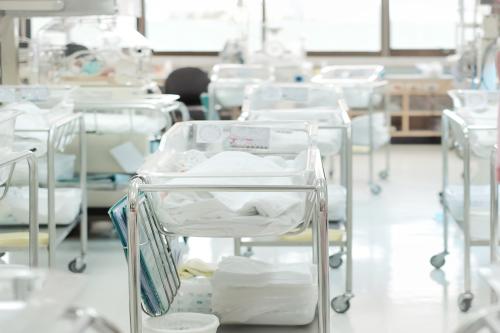Recently released official U.S. birth data for 2020 showed that births have been falling almost continuously for more than a decade. For every 1,000 women of childbearing age (15 to 44), 55.8 of them gave birth in 2020, compared to 69.5 in 2007, a 20 percent decline. The “total fertility rate,” which is a measure constructed from these data to estimate the average total number of children a woman will ever have, fell from 2.12 in 2007 to 1.64 in 2020. It is now well below 2.1, the value considered to be “replacement fertility,” which is the rate needed for the population to replace itself without immigration.
However, the total fertility rate calculated from annual birth data might be a misleading indicator of actual future fertility rates. It is only an appropriate indicator of the total number of children women will have, on average, if the age profile of childbearing is static. As some have pointed out, women today might just be delaying their births, but they could go on to ultimately have the same number of total children, on average, as women before them. If so, today’s low birth rates will rebound in future years, and the current decline will prove to be a temporary phenomenon. Alternatively, if women both delay childbearing and do not compensate with more births at later ages, the recent decline is likely to reflect a persistently lower level of births.
Low birth rates and below replacement level fertility rates in the U.S. are probably here to stay for the foreseeable future.
We attempt to distinguish between these two alternatives by tracking birth histories of successive cohorts of women over the past 30 years. The data reported this way provide evidence that women are both delaying childbearing and having fewer total births. This implies that the latter alternative is more likely: low birth rates and below replacement level fertility rates in the U.S. are probably here to stay for the foreseeable future.
Using contemporaneous birth data to forecast fertility trends may be inaccurate
We know that women are having their first child at older ages than in the past. The median age at first birth has risen from 22.7 in 1980 to 24.9 in 2000 and 26.9 in 2018. Just because women start later, though, does not mean that they will have fewer births over their entire childbearing years.
The standard calculation of the “total fertility rate” assumes that the age profile of childbearing observed in a single year can be applied to a woman’s lifetime. It is constructed by adding up the likelihood that a woman gives birth at each age as observed in the data that year. It assumes that young women today will have the same birth rates at older ages as women at later childbearing ages today.
If birth rates across ages are stable over time, then the total fertility rate will accurately capture the average number of children a woman will have over her lifetime. But, if birth rates across ages are not stable, this statistic will inaccurately forecast lifetime births. In particular, if women are having the same total number of children, but at older ages, the total fertility rate will temporarily fall.
Birth patterns by age for successive cohorts of women support lower lifetime fertility
Data tracking births of different cohorts of women (born at the same time) more accurately capture trends in fertility, albeit at the expense of incomplete data for women whose childbearing years are not yet complete. We examine these Vital Statistics birth data to gain further insight. Figure 1 plots the age profile of childbearing for women born between 1975 and 2000 in five-year intervals. These data show a clear age profile: births rise through the early to mid-20s and then start declining in the early 30s.
They also show that successively younger cohorts of women are having fewer births at all observed ages. The 1975 and 1980 birth cohorts had very similar birth-age profiles, in terms of both levels and profile shape. Every successive cohort after that have had considerably fewer births through age 30. These age profiles suggest that to maintain the total childbearing rates of earlier cohorts, women who are now in their 20s and 30s will have to have substantially more births after age 30 than earlier cohorts. (We have replicated this analysis using data from the June fertility supplements of the Current Population Survey and find the same pattern.)

The markers in Figure 1 reflect each cohort’s age at the onset of the Great Recession in 2008. Women in the 1995 and 2000 birth cohorts were not yet childbearing age at that point. These data show a dip in births in the years following the onset of the recession. They also show that birth rates returned to predicable paths afterwards. This is consistent with the Great Recession leading to an important but short-term reduction in fertility.
Figure 2 translates these childbearing age profiles into total number of children ever born by a certain age. The figure clearly shows that successively younger cohorts of women are having fewer children by specific ages. For instance, by age 24, the 1995 birth cohort of women had 38 percent fewer children than the 1975 and 1980 birth cohorts had at that age (0.5 compared to 0.8). This younger cohort would need to have 21 percent more children at each age from 25 through 44 to “catch up” to the earlier cohorts in terms of total lifetime childbearing. As another example, the 1990 birth cohort has had 21 percent fewer births through age 29 compared to the 1975 and 1980 cohorts; they would need to have 38 percent more births in their remaining childbearing years to catch up in terms of lifetime fertility.

Younger women TODAY NOW ARE LIKELY TO HAVE FEWER CHILDREN COMPARED TO PREVIOUS COHORTS OF WOMEN
Women in the 1975 through 1980 birth cohorts had an average of around 2.2 total lifetime births. What should we expect for the more recent birth cohorts who have not yet completed their childbearing years?
We simulate the total number of children ever born for the younger cohorts of women under three different scenarios. The “conservative” scenario applies the age profile in childbearing observed for the 1975 through 1980 birth cohorts (the “baseline” rate – a smoothed version of the observed rates for these cohorts) to the remaining ages of the more recent birth cohorts of 1985, 1990, and 1995. The “moderate” scenario assumes that births converge to the same level of the 1975 and 1980 cohorts by age 30 and then follows their age-profile after that. The “aggressive” scenario assumes that births converge by age 30 to a level that is 10 percent higher than the 1975 and 1980 cohorts’ level and stays elevated after that.
Figure 3 illustrates this simulation approach for the 1995 birth rate. The solid pink line represents observed births through age 24 and the dotted lines represent simulations based on these different assumptions.

Table 1 reports the forecasted number of children ever born based on these simulated age profiles for the 1985 through 2000 birth cohorts. Under all three scenarios, the total number of children ever born per woman is expected to fall for more recent birth cohorts. Regardless of assumptions, all cohorts past 1985 are predicted to fall short of replacement fertility. For the 1995 birth cohort, the simulated total number of children born per woman is 1.61 under the conservative scenario, 1.86 under the moderate scenario, and 1.97 under the aggressive scenario. Each of those values is lower for the 2000 birth cohort (1.44, 1.77, and 1.92, respectively).
Table 1: Forecast Number of Children Ever Born by Mother’s Birth Cohort
|
Cohort |
Conservative Approach |
Moderate Approach |
Aggressive Approach |
| 1975-1980 “baseline” | 2.20 | 2.20 | 2.20 |
| 1985 | 2.16 | 2.16 | 2.19 |
| 1990 | 1.93 | 1.99 | 2.07 |
| 1995 | 1.61 | 1.86 | 1.97 |
| 2000 | 1.44 | 1.77 | 1.92 |
Notes: See notes to Figure 3.
This analysis implies that U.S. fertility rates are likely to be considerably below replacement levels for the foreseeable future. This is driven by more than a decade of falling birth rates and declining births at all ages for multiple cohorts of women, not simply the aftermath of the pandemic-induced reduction in births. Furthermore, the simulated fertility rates we report in this essay are similar to those observed in virtually all other high-income countries. This evidence leads us to expect that U.S. birth rates and total completed fertility rates are not likely to rebound any time soon. Further research is needed to better understand the reasons for the long-term decline and what, if any, policy responses are warranted.







Commentary
Will births in the US rebound? Probably not.
May 24, 2021